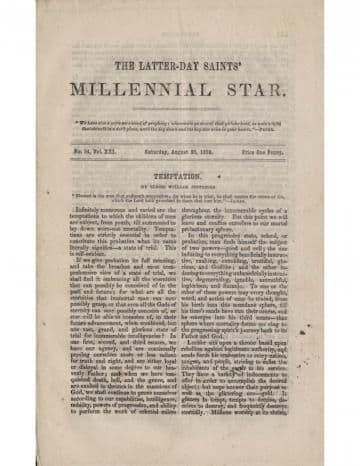Magazine
American Antiquities: Corroborative of the Book of Mormon (20 August 1859)

Title
American Antiquities: Corroborative of the Book of Mormon (20 August 1859)
Magazine
The Latter Day Saints' Millennial Star
Publication Type
Magazine Article
Year of Publication
1859
Editors
Calkin, Asa (Secondary)
Number of Pages
546
Date Published
20 August 1859
Volume
21
Issue Number
34
Abstract
This 47-part series provides evidence to confirm the authenticity of the Book of Mormon. It describes the contents of the Book of Mormon and archaeological findings and discoveries, such as ancient cities, temples, altars, tools, and wells. Each part contains several excerpts from other publications that support the Book of Mormon.
AMERICAN ANTIQUITIES,
CORROBORATIVE OF THE BOOK OF MORMON.
(Continued from page 514.)
(From the San Francisco Weekly Herald.)
The past few years have been rich in the discoveries of the remains of ancient grandeur. How sad the comment upon humble pride are the ruins fast coming to light, that tell us of mighty nations far surpassing us in the splendour of their monuments and the magnitude of their works, that have flourished, disappeared, and left not a record of their existence, save these dumb witnesses of their greatness! The learned have for years been exploring the seats of ancient empires in the East, and wonderful have been the revelations that have rewarded their search. America is as rich, and as yet an almost untried field for the researches of the antiquarian. Monuments everywhere exist, which show that this continent was once peopled by a race of rare attainments, far advanced in the arts, and numerous as the sands of the ocean. Who were they?—what has become of them? are questions that none can answer.
(From Julius Froebel’s “Seven Years’ Travel in Central America, Northern Mexico, and the Far West of the United States,” published in London, 1859.)
“The place, indeed, [Carrizal, North Mexico,] is full of ruins, and lies on a raised platform consisting of hard red clay, with pebbles and fragments of sandstone, evidently changed by the influence of heat, red porphyry, black scariaceous lava, yellow and green scoriae, much resembling pumice and numerous pebbles of chalcedony. … The town of Chihuahua derived its ancient wealth and splendour from the rich mines of Santa Eulalia, and the decline of the town has followed that of the mines. … The whole design of the town with its pleasant streets and many noble edifices, marks the past periods of its splendour; and even in its present decay it is far more beautiful as a whole, than any town of similar pretension in the United States. The reader may form some idea of the vast quantities of silver ore formerly smelted here, when I mention that hundreds of houses and the walls of all the gardens and fields in the environs are built of the scoria, in which, according to trustworthy analysis, enough silver remains to make fresh smelting, under better and more scientific management, a profitable undertaking. Forty-three millions of marks of silver have been the produce of these mines in 130 years. … On the Gila, figures and characters [“hieroglyphics”] are cut on rocks which cannot be climbed without difficulty; also on precipitous sides of rocks which could not be reached without mechanical contrivance. It is scarcely to be imagined that men would take the trouble to get at such places, and there to carry out a difficult and laborious work unless they had some important end in view; and the more so, since rocks and masses of stone abound close by, where the operation might have been effected easily, had it been undertaken merely for amusement. I saw at the summit of a lofty and steep mountain near the Gila, below the region of the lava terraces to which I have above referred, [“A broad terrace of doleritic lava, with perpendicular sections towards the valley,”] the rocks covered with these characters. Old footpaths, in places trodden into the rock occur in great numbers along the side of the mountains, all tending to the summit. In my opinion, these footpaths could only have been formed during many centuries of constant use; and it is impossible not to draw the conclusion that some important object was connected with them and with the characters carved on those rocks. … One of the carvings by the Gila is particularly interesting as occuring on a rock on the precipitous side of lava terraces, the present position of which half covered by another mass, hiding part of the carving, proves that the changed position of the rocks. Through some natural phenomenon, is of later date than the figures. Other engravings, also taken from the lava walls along the Gila have more the character of an inscription, or of the communication of connected thoughts, than any other that I saw. A desert covered with pebbles and fragments of granite, porphyry, syenite, greenstone, jasper, &c., &c., extends above the lava terraces, on each side of the Gila.”
(To be continued.)
Subject Keywords
Bibliographic Citation
Terms of use
Items in the BMC Archive are made publicly available for non-commercial, private use. Inclusion within the BMC Archive does not imply endorsement. Items do not represent the official views of The Church of Jesus Christ of Latter-day Saints or of Book of Mormon Central.